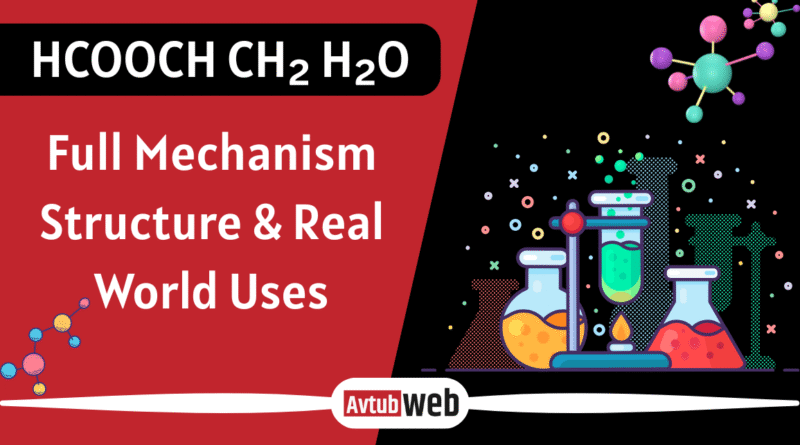HCOOCH CH2 H2O Reaction Explained: Full Mechanism, Structure & Real-World Uses
The reaction involving HCOOCH CH2 H2O is an important chemical process where methyl formate (HCOOCH) interacts with water (H₂O), often in the presence of a methylene group (CH₂). This reaction typically breaks down the ester bond in methyl formate through a process called hydrolysis, producing formic acid and methanol. The methylene group can also participate, helping form new compounds. This reaction happens step by step, with water molecules attacking the ester and causing it to split apart. It’s widely used in making everyday products like biodegradable plastics, solvents, fuels such as biodiesel, and pharmaceuticals. Understanding how this reaction works helps scientists create greener, more efficient chemical processes that support industries like agriculture, textiles, and personal care.
What is HCOOCH CH2 H2O? Understanding the Reactants
This reaction includes three main parts: methyl formate (HCOOCH), the methylene group (CH₂), and water (H₂O). Methyl formate is an ester made from formic acid and methanol and is often used as a solvent in making medicines. The methylene group is very reactive and helps connect molecules by forming bridges. Water plays an important role by breaking the ester bond and helping stabilize parts of the reaction through hydrogen bonding. Together, these molecules work in different chemical processes related to making biodegradable materials, fuels, adhesives, and eco-friendly chemistry.
The Overall Chemical Reaction: What Happens When HCOOCH Reacts with Water
The key reaction here is the breaking down of methyl formate by water, called ester hydrolysis. When methyl formate reacts with water, it splits into formic acid and methanol. Sometimes, the methylene group also takes part, helping build bigger molecules. This reaction is important in making polymers, renewable energy products, and chemicals used in farming.
Step-by-Step Reaction Mechanism: Nucleophilic Attack and Ester Hydrolysis
The reaction happens in several steps. First, the oxygen in the methyl formate’s carbonyl group gains a proton. Then, water attacks the carbonyl carbon. This forms a temporary shape called the tetrahedral intermediate, which is held stable by hydrogen bonds. Finally, the bond breaks, releasing methanol and restoring the acid catalyst. This acid-driven process is important in many areas like soap-making, drug creation, and making plastics that break down naturally.
Molecular Structure Breakdown of HCOOCH CH2 H2O
Each molecule has a distinct structure and role in the reaction. Methyl formate acts as the ester that gets broken down. Water acts as the nucleophile that attacks the ester bond. The methylene group adds into carbon chains to create larger molecules. These parts are important in making adhesives, flavoring substances, and plastics.
Each molecule contributes to the total structure:
| Molecule | Structural Formula | Role in Reaction |
|---|---|---|
| Methyl Formate | HCOOCH₃ | Ester, undergoes hydrolysis |
| Water | H₂O | Nucleophile, reacts with ester |
| Methylene (CH₂) | :CH₂ (singlet/triplet) | Adds into carbon chains |
Electron Flow and Bond Rearrangement During the Reaction
During the reaction, electrons move in specific ways. The lone pair of electrons on water’s oxygen attacks the carbonyl carbon of methyl formate. At the same time, electrons in the ester’s double bond shift after it gains a proton. Later, the bond between oxygen and the methyl group breaks. These electron movements help lower the energy needed for the reaction and are important in catalyst design and studies of how molecules bind.

Thermodynamic and Kinetic Considerations
This reaction releases energy under acidic water conditions, so it happens on its own. The energy needed to start the reaction drops when acids or bases are present as catalysts. The balance of the reaction shifts toward breaking the ester when there is a lot of water. Understanding these energy and speed factors helps in designing environmentally friendly chemical processes and conserving resources.
Role of Catalysts and pH in Reaction Rate
Both acids and bases can speed up the reaction but work differently. Acidic conditions make the reaction faster by helping protonate the ester. Basic conditions work through hydroxide ions and can be quicker under strong bases. The reaction works best in certain pH ranges: mildly acidic (2 to 5) or mildly basic (9 to 11). Controlling pH this way allows precise chemical reactions and helps model how enzymes work in living systems.
Key Intermediates and Transition States Visualized
During the reaction, several important short-lived structures appear. First, water attacks forming a tetrahedral intermediate with high energy but short life. Proton transfers create protonated intermediates that are stabilized by surrounding water molecules. Then, methanol leaves the molecule, with electrons moving around to spread out the charge. These steps are important in new technologies like nanotech, drug formulation, and catalyst design.
| Step | Intermediate | Transition State Characteristics |
|---|---|---|
| Nucleophilic attack | Tetrahedral intermediate | High energy, short-lived |
| Proton transfers | Protonated intermediates | Stabilized by water |
| Leaving group departure | Methanol release | Electron delocalization |
Lab Synthesis of HCOOCH CH₂ H₂O Derivatives: Methods & Tools
In the lab, these reactions are done by heating methyl formate with sources of methylene groups in water under reflux. Catalysts like palladium, copper, or iron salts help increase yield. Scientists track the reaction progress using instruments like gas chromatography, infrared, and nuclear magnetic resonance spectroscopy. These methods help develop new polymers, biodegradable plastics, and chemical derivatives of formate. You can read the full breakdown of the HCOOCH + CH₂ + H₂O reaction mechanism and its applications here.
Industrial-Scale Applications: From Solvents to Pharma
Methyl formate is widely used as a solvent in textile processing, leather treatment, and making fragrances. It’s also a starting chemical in making medicines and skin care products. In fuel industries, formic acid made from this reaction serves as a carrier for hydrogen fuel. Because methyl formate is considered a green solvent, it supports eco-friendly manufacturing and improves chemical production efficiency.
Comparison with Similar Ester Reactions in Organic Chemistry
This reaction is like others where esters react with water, but with some differences. For example, methyl acetate breaks down into acetic acid and methanol, and ethyl formate into formic acid and ethanol. The methyl formate reaction is special because the methylene group can add, forming more versatile intermediates. Knowing how these reactions differ helps in making specialty plastics, dyes, and other useful chemicals.
| Reaction | Type | Key Feature |
|---|---|---|
| Methyl acetate + H₂O | Ester hydrolysis | Yields acetic acid + methanol |
| Ethyl formate + H₂O | Ester hydrolysis | Yields formic acid + ethanol |
| Methyl formate + CH₂, H₂O | Enhanced reactivity | Forms more versatile intermediates |
Physical and Chemical Properties of the Reaction Products
Formic acid is a colorless liquid with a sharp smell and has a pKa around 3.75, making it a weak acid. Methanol is a clear, polar liquid with a boiling point of about 65 degrees Celsius. The methylene products are often reactive species like radicals or carbenes. These products are used as green solvents, in environmental cleaning, and in energy-saving technologies.
Handling, Safety Protocols, and Environmental Impact
These chemicals need to be stored in cool, well-ventilated areas and kept in sealed containers. When working with them, wearing gloves and goggles and using a fume hood is important. Waste must be neutralized properly and disposed of according to regulations to prevent pollution. Following safety rules protects people and the environment and complies with legal standards.

Common Mistakes and Misconceptions in Understanding the Mechanism
People sometimes confuse ester hydrolysis with the reverse process, esterification. They may forget water acts both as a solvent and a reactant. Others overlook how temperature and pressure affect the reaction speed. Being aware of these points is key for successful use in chemical manufacturing or research.
Current Research Trends and Unanswered Questions
Scientists are using artificial intelligence to predict how bonds break and reactions proceed. Research is also focused on using formic acid as a sustainable hydrogen storage method, such as in flow batteries. Enzymes that mimic natural inhibitors are being designed to make the reaction more efficient. Studies continue into how catalysts work, how to screen them better using computers, and how these reactions can help fight climate change.
Conclusion
The reaction between methyl formate, methylene, and water is a key step in making many important molecules. It connects acid-base chemistry with sustainable production and energy-saving methods. Because it’s used in flavorings, adhesives, biodegradable plastics, and fuels, it plays a vital role in modern science and industry.
Frequently Asked Questions
What is HCOOCH CH₂ H₂O?
It’s a reaction mixture involving methyl formate (HCOOCH), a methylene group (CH₂), and water (H₂O), often used in chemical and industrial processes.
How is HCOOCH CH2 H2O synthesized?
It’s made by combining methyl formate with water and a methylene source, usually under controlled lab or industrial conditions with heat or a catalyst.
What are the primary uses of HCOOCH CH₂ H₂O?
It’s used in making formic acid, methanol, biodegradable materials, solvents, and intermediates for pharmaceuticals and plastics.
Is HCOOCH CH₂ H₂O safe for use?
Yes, when handled with care. Safety measures like gloves, goggles, and good ventilation are needed to avoid skin or eye irritation.
What are the future prospects for HCOOCH CH2 H2O?
It has a strong future in green chemistry, especially for making eco-friendly fuels, biodegradable plastics, and sustainable industrial products.
Can this reaction help reduce pollution?
Yes. It supports cleaner production methods and helps replace toxic chemicals in solvents, fuels, and other materials.
Does this reaction need a catalyst?
Often yes. Acid-catalyzed or base-catalyzed conditions are used to speed up the hydrolysis and make it more efficient.
Is the reaction fast or slow?
It depends on the temperature, pH, and catalysts. With the right setup, it’s fairly quick and efficient.
What kind of industries use this reaction?
Industries like pharmaceuticals, textiles, agriculture, plastic manufacturing, and fuel production use it.
Is this reaction part of renewable energy technology?
Yes. It helps in producing biodiesel, hydrogen fuel carriers, and other energy-efficient solutions.
Read Our Other Articles
Read More



